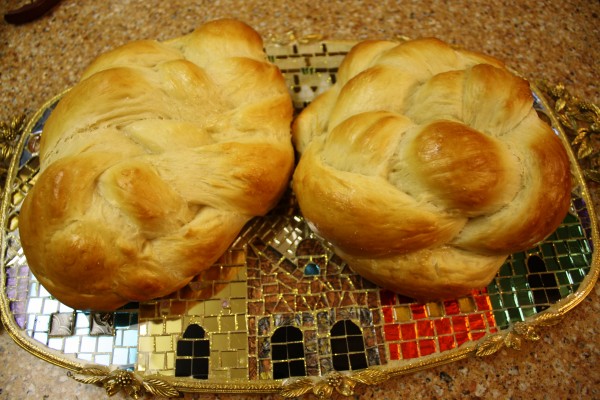Happy birthday to our big sister, Rayna! This year, instead of a birthday cake, you get a birthday challah:
We already have a few of challah recipes on this blog, but I always like to try new ones. This recipe splits up the process into two days, but I’m pretty sure you can use the same process for most other challah recipes; just make the dough and let it rise overnight in the fridge rather than a couple of hours at room-temperature.
Here, I display my loaves, one 6-strand braid and one 4-strand circle, on my beautiful new challah board that my Aunt Joyce made.
Ever since I saw this post, I wanted to try the egg yolk challah. I could always use the leftover egg whites 1) as the egg wash and 2) to practice my French macaron skills! But, as usual, I waited a long time to make it. Nossi beat me to it, which reminded me about it, but still, I waited and waited, until I could wait no longer!
Peter Reinhart’s Two-Day Challah, via Ruhlman.com
Ingredients:
- 2 ½ cups/510 grams lukewarm water (about 95 degrees)
- 1 ½ tablespoons/14 grams instant yeast
- 8–10 egg yolks or 170 grams depending on weight of yolks
- 5 tablespoons/71 grams vegetable oil
- 6 tablespoons/85 grams sugar, or 4 ½ tablespoons/96 grams honey or agave nectar
- 1 tablespoon/21 grams vanilla extract (optional)
- 7 ½ cups/964 grams unbleached bread flour
- 2 ½ teaspoons/19 grams salt or 4 teaspoons/20 grams coarse kosher salt
- 1 egg white for egg wash
- 2 tablespoons/30 grams water for egg wash
- 2 tablespoons/20 grams sesame or poppyseeds for garnish
- Combine the water and the yeast in a mixing bowl or the bowl of a 5-quart mixer and whisk together to dissolve. Add the egg yolks, oil, sugar, and vanilla, if using, and whisk together to break up then add the flour and salt.
- Using the paddle attachment, mix the dough for 2 minutes on the lowest speed. Let the dough rest for 5 minutes.
- Switch to the dough hook and mix on medium low for 4 minutes.
- Use a floured bowl scraper or floured hands to transfer the dough to a lightly floured surface, sprinkle the top lightly with flour and knead by hand for a couple of minutes until the dough is soft and supple. It should be tacky but not sticky.
- Place the dough in a lightly oiled bowl, or divide the dough in half or in as many portions as you plan to bake, and place in oiled bowls. Cover and immediately place in the refrigerator. The dough should rest at least overnight and can be kept refrigerated for up to 4 days.
On Baking Day (keep in mind that you need about two hours before baking):
- Remove the dough from the fridge. Transfer it to a lightly floured surface and cut it into the desired number of braids you want to use or shape into loaves, or dinner rolls.
- If you are braiding, flatten each piece with your hand, then roll into cigar shaped lengths. Roll each piece once, then return to the first piece to roll it into a rope. Make sure it will fit on your baking sheet!
- Roll each piece to the same length then braid. Place the loaves on sheet pans lined with parchment paper.
- Make egg wash and brush each loaf with the wash. Reserve the rest of the wash in the fridge, and let the loaves rise uncovered for about an hour. They will not have risen much at this point. Brush the loaves again with the egg wash and sprinkle with poppy seeds or sesame seeds or a combination of both, if desired.
- Let the loaves rise for another hour until they increase to about 1 ½ times their size.
- 15 minutes before baking, pre-heat the oven to 350 degrees.
- Bake for 20 minutes, then rotate the pan and bake for another 15 to 30 minutes, until the loaves sound hollow when thumped on the bottom, If you used a whole egg wash, the crust will get darker than with the egg white wash, so don’t be fooled into thinking the bread is done until it passes the thump and temperature test.
- Cool on a wire rack for at least 45 minutes before slicing and serving.
Recipe – Makes 2 large loaves or 4 small ones.
Variations: If you want to use whole eggs instead of yolks in the dough, reduce the water by 2 tablespoons (1 oz/28.5 g) per egg. The yolks are the key to the attractive color and also make a major contribution to the soft texture because they add fat and lecithin, which tenderize the bread. The whites add protein; while that’s a good thing, they also dry out the bread. Also, feel free to add another tablespoon or so of honey or sugar if you prefer a sweeter bread.


